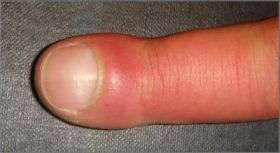Medics solve an ancient riddle -- and offer new tool for diagnosis

A puzzling medical condition, identified more than 2,000 years ago by Hippocrates, has finally been explained by researchers at the University of Leeds.
The phenomenon of "finger clubbing", a deformity of the fingers and fingernails, has been known for thousands of years, and has long been recognized to be a sign of a wide range of serious diseases – especially lung cancer.
"It's one of the first things they teach you at medical school," explained Professor David Bonthron of the Leeds Institute of Molecular Medicine. "You shake the patient by the hand, and take a good look at their fingers in the process."
Lung cancer, heart disease, hyperthyroidism, various gastrointestinal diseases and many other conditions all result in finger clubbing. But exactly why swollen, reddened fingers should be an indicator of serious illness has remained a mystery – until now.
"There are benign cases of clubbing, where it isn't associated with other illnesses, but particularly because of the link to lung cancer, it is generally regarded as rather sinister," said Bonthron. "You look at the range of conditions connected to finger clubbing and wonder what on earth they could have in common."
The researchers found clues in the medical literature, detailing past cases and previous research. "We knew that in cystic fibrosis patients who have undergone a lung transplant, their finger clubbing goes away. The same goes for empyema patients who have had their lungs drained. It suggested that impaired lung function was somehow crucial to finger clubbing – but we didn't understand how."
Prof Bonthron, Dr Chris Bennett of the Yorkshire Regional Genetics Service and their colleagues studied a group of patients suffering from inherited primary hypertrophic osteoarthropathy (PHO), a genetic disorder in which the finger clubbing is accompanied by painful joint enlargement and a thickening of the bone.
Their findings implicated a fatty compound called PGE2, which is produced naturally by the body to mediate the effects of internal inflammation. Crucially, once it has done its work, PGE2 is broken down by an enzyme 15-HPGD, produced in the lungs. The patients followed by the Leeds study were found to have a genetic mutation which prevented the production of 15-HPGD, reulting in up to ten times as much of the PGE2 in their systems.
"If you don't have this enzyme the PGE2 isn't broken down normally and simply builds up," said Bonthron, whose findings are published online this week in Nature Genetics.
In lung cancer patients, it is most likely overproduction of PGE2 by the tumour that causes the clubbing. In congenital heart disease, blood bypasses the lungs, where PGE2 is normally broken down by 15-HPGD.
The researchers have suggested that a straightforward urine test for levels of PGE2 may be a useful first step in the diagnosis of individuals with unexplained clubbing, and to understanding whether it is the symptom of something far more serious. The results also suggest that existing drugs such as aspirin, which are already used to prevent PGE2 production, may be effective in reducing the painful symptoms of finger clubbing.
It has taken 2,000 years to make the connection, but Bonthron adds: "Actually, when you look back, it's rather obvious. When we found this gene, everything else fell neatly into place – it was like a smack on the forehead."
Citation: Uppal S, Diggle CP, Carr IM, Fishwick CWG, Ahmed M, Ibrahim GH, Helliwell PS, Latos-Bielenska A, Phillips SEV, Markham AF, Bennett CP, Bonthron DT (2008) Mutations in 15-hydroxyprostaglandin dehydrogenase cause primary hypertrophic osteoarthropathy is published on the Nature Genetics website.
Source: University of Leeds





















